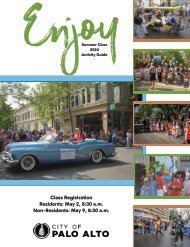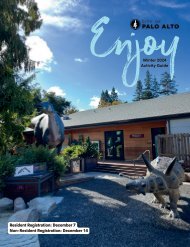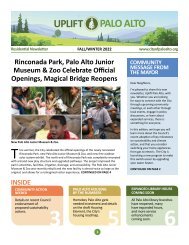Palo Alto Economic Development Strategies
Create successful ePaper yourself
Turn your PDF publications into a flip-book with our unique Google optimized e-Paper software.
RETAIL MARKET ASSESSMENT<br />
The economic development strategies outlined herein represent a practical roadmap for public and private<br />
interventions that advance the City’s post-pandemic recovery of retail shopping districts. The following is a<br />
summary of the diagnostic conclusions that ultimately informed the guiding principles and recommended<br />
strategies. The full diagnostic can be found in the March 13, 2023 City Council Work Session Staff Report.<br />
REGIONAL and LOCAL RETAIL COMPETITION<br />
Regionally-serving, experience-based retail centers, including malls, power centers, and walkable downtowns and<br />
lifestyle centers, are characterized by a dominant mix of good-based retail. These retail centers attract customers<br />
from a larger regional trade area and feature a cluster of full-service restaurants and entertainment. There are five<br />
regional malls of varying quality closer to San Jose and only one traditional mall to the west, Hillsdale Shopping<br />
Center. Even with steep competition, the top performing mall in the region is Stanford Shopping Center. The<br />
region is also rich with competitive Downtown retail environments, including Downtown Menlo Park, Mountain<br />
View, Redwood City, Los <strong>Alto</strong>s, and Burlingame, which also compete with malls and lifestyle centers. Locally,<br />
Downtown <strong>Palo</strong> <strong>Alto</strong> not only competes with Stanford Shopping Center but also California Avenue, a more<br />
community serving retail environment, spreading retail quite thin across the City.<br />
Neighborhood serving retail centers are characterized by a dominant mix of Neighborhood Goods & Services<br />
(NG&S) tenants, often grocery-anchored. These retail centers primarily meet the need for convenience-based<br />
shopping trips competing on a geographically smaller scale. Grocery competition is strong throughout the region.<br />
Big box retailers are not permitted in <strong>Palo</strong> <strong>Alto</strong> by regulation but are concentrated along the periphery of <strong>Palo</strong> <strong>Alto</strong>,<br />
cannibalizing the retail offerings within the City. Target and Costco are particularly prevalent in the region, with<br />
nine and seven stores respectively within the studied area.<br />
RETAIL VACANCY and RENTS<br />
Vacancy among the six retail districts totals 243,000 square feet, or about 8% vacancy rate, as of year-end<br />
2022. A majority of vacant space is concentrated in Downtown <strong>Palo</strong> <strong>Alto</strong>, accounting for about 88,000 square<br />
feet. California Avenue has the highest vacancy rate among all districts at 15%, accounting for 31,000 square feet.<br />
There is about 57,000 square feet currently vacant within Stanford Shopping Center, which equates to a low<br />
vacancy of 4%, due to the mall's large size. This<br />
vacancy is caused by smaller tenants inside the<br />
mall rather than by the loss of an anchor. Most<br />
importantly, Stanford Shopping Center captures<br />
spending that might otherwise be spent in other<br />
<strong>Palo</strong> <strong>Alto</strong> districts, especially Downtown <strong>Palo</strong> <strong>Alto</strong>,<br />
by offering attractive co-tenancy opportunities, a<br />
high-amenity environment, and retail-appropriate<br />
spaces.<br />
Retail rents in the region are high with average<br />
asking rent at $63.52 per square foot, 130% higher<br />
than the national average of $27.55 per square foot Source – REIS, Loopnet, Michael Baker, CoStar 2022<br />
for malls and downtown environments. Stanford Shopping Center has the highest average asking rents in <strong>Palo</strong> <strong>Alto</strong><br />
at just over $77.00. Town & Country Village and Downtown <strong>Palo</strong> <strong>Alto</strong> are comparable with average rents at<br />
between roughly $72.00 and $76.00 per square foot, respectively.<br />
DEMAND<br />
Retail demand is based on resident, employee, overnight guest, and daytime visitor spending, local and regional<br />
competition, and projected population growth. Importantly, hybrid work has reduced the demand for retail in<br />
<strong>Palo</strong> <strong>Alto</strong> by over 100,000 square feet, roughly equivalent to the amount of retail space at Midtown and<br />
Charleston Shopping Center combined. The reduction in <strong>Palo</strong> <strong>Alto</strong>'s daytime population means less spending<br />
available to support retailers. That said, there is a significant development pipeline in the surrounding markets. At<br />
full build out, these projects will add 17,700 residential units, 15.8 million square feet of office/life science space,<br />
and 2,300+ hotel keys. The additional density and daytime population will improve these competitive markets,<br />
making them more compelling locations for retailers.<br />
At this time, 2032 projections suggest that <strong>Palo</strong> <strong>Alto</strong> can support approximately 2.7 million square feet, with 15%<br />
of total retail demand in Neighborhood Goods & Services (NG&S), 22% in Food & Beverage (F&B), and 63% in<br />
General Merchandise, Apparel, Furniture, and Other (GAFO). More specifically:<br />
• GAFO makes up more than half of demand, driven by Stanford Shopping Center, which consumes 80%,<br />
with a remaining 321,730 square feet of GAFO demand to be distributed among the other districts.<br />
• Neighborhood-serving retail demand is constrained by the presence of big box retailers just outside the<br />
City’s boundaries. However, given the population density and high spending levels, the market may be able<br />
to support additional neighborhood-serving retail on a small scale.<br />
• Food & Beverage is seeing healthy demand in fast casual serving student and employee populations, as<br />
well as full-service, sit-down restaurants.<br />
Retail demand will steadily increase;<br />
however, without intervention, demand will<br />
not reach parity with the existing retail<br />
supply over the next 10 years. Because of the<br />
460,000 square feet of projected oversupply,<br />
vacancy will continue to rise among lower<br />
quality or poorly positioned space.<br />
OPPORTUNTIIES<br />
To better support <strong>Palo</strong> <strong>Alto</strong>’s retail districts, a<br />
more balanced ecosystem of uses should be<br />
introduced to increase daytime population,<br />
activation, duration of stay, and spending. A<br />
broader mix of uses including residential,<br />
office space for sectors requiring more inperson<br />
work, entertainment, civic, and<br />
cultural uses are recommended.<br />
Source: Michael Baker; Streetsense analysis 2022<br />
PALO ALTO, CA —————————— ECONOMIC DEVELOPMENT STRATEGIES<br />
9
















